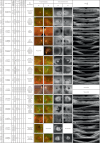Variants in CFAP410 cause a range of retinal and skeletal phenotypes
- PMID: 40246852
- PMCID: PMC12006490
- DOI: 10.1038/s41525-025-00489-1
Variants in CFAP410 cause a range of retinal and skeletal phenotypes
Abstract
Ciliopathies are associated with a range of phenotypes including retinal degeneration and skeletal abnormalities. We present a retrospective study of 49 patients with variants in Cilia and Flagella Associated Protein 410 (CFAP410) from multiple ophthalmic centers across the world. Common clinical features included early-onset reduced visual acuity, photophobia, and delayed light-to-dark adaptation. A cone-rod dystrophy pattern was observed roughly two times more commonly than rod-cone dystrophy. A minority of patients (22.4%) presented with skeletal abnormalities consistent with axial spondylometaphyseal dysplasia (SMDAX). Patients with the most severe ophthalmic and skeletal phenotypes had disease-associated variants within conserved leucine-rich regions of CFAP410, and the structural effects of these variants were modelled using ChimeraX. This report furthers our understanding of CFAP410-associated clinical phenotypes such as retinal dystrophy and skeletal dysplasia.
© 2025. The Author(s).
Conflict of interest statement
Competing interests: The authors declare no competing interests.
Figures



References
-
- Scott, H. S. et al. Characterization of a novel gene, C21orf2, on human chromosome 21q22.3 and its exclusion as the APECED gene by mutation analysis. Genomics47, 64–70 (1998). - PubMed
Grants and funding
LinkOut - more resources
Full Text Sources

